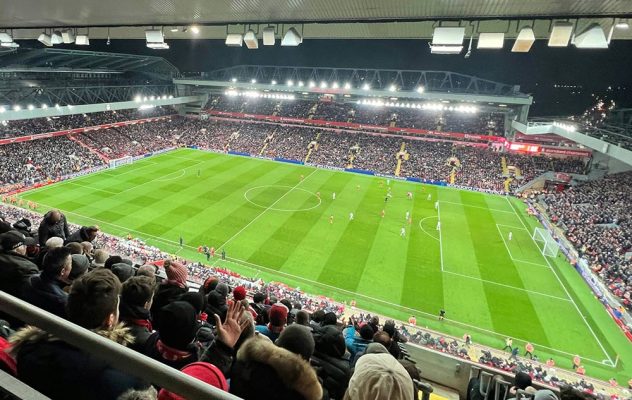



„I got told outside there is an English phrase: ‚You don’t win trophies with kids‘. I didn’t know that,“ said Jürgen Klopp and, after a look at the gathered press, added with a broad grin: „Write it new.“ His team had just beaten Chelsea FC 1-0 after extra time in the final of the EFL Cup. The winning team was no ordinary one.
Trent Alexander-Arnold, Darwin Nunez and Dominik Szoboszlai were absent through injury, while six players between the ages of 18 and 21 from the club’s own youth academy were fielded. And that against the Blues, whose starting eleven market value was around 100 million euros higher than that of Liverpool. Talent development at the limit. „In my 20-year coaching career, this is by far the most special title,“ said Klopp after his seventh final success as LFC coach.
Players such as Conor Bradley or Jayden Danns from Liverpool, but also Kobbie Mainoo from Manchester United and Jack Hinshelwood from Brighton are representative of the developmental step that many Premier League clubs have taken in recent years. The battle for the best and most expensive players on the transfer market has turned into a battle for the best talent and the best academy.
Reigning champions Manchester City prove that this talent competition and the associated investments more than pay off in the long term with the biggest figures. At the end of 2014, the club opened the City Football Academy, a new training centre not far from the Ethiad Stadium, at a cost of around €235 million. Since then, the Citizens have not only won six championships and one Champions League title. From 2017 onwards, the club generated over €300 million in transfer revenue through the sale of young talent until 2023. Other figures show that the club still spends large sums on external players on the transfer market. The transfer balance since 2019 shows a minus of around 378 million euros. In the coming years, the club will have to focus even more on training its own talent in order to avoid penalties under the Financial Fair Play regulations.
However, talent development on a grand scale is not only happening at club level. The Premier League is also leading the way in international football with projects such as the Elite Player Performance Plan (EPPP), which was initiated twelve years ago, and the recently launched Football Intelligence Platform. The aim is clear: to develop young footballers as specifically as possible in the best possible environment – with the help of the latest training technology and data science methods.
The focus on well-trained, young players is becoming increasingly noticeable in international competition. On average, Premier League squads have become 1.1 years younger over the past 20 years. This means that the best league in the world is also the youngest compared to the other top leagues in Germany, Italy and Spain. The German Bundesliga has made the biggest leap in the past two decades, with squads there becoming 1.3 years younger on average. Personnel decisions at record champions FC Bayern Munich reinforce the impression that this development is far from over. Since the beginning of his time in charge, sporting director Christoph Freund has clearly focussed on integrating the academy more closely into professional operations and therefore installed a dedicated talent development coordinator.
However, structured talent development is not a question of budget. What the top teams practise at the highest level with the corresponding financial resources, smaller leagues and teams do even more radically and are therefore comparatively even more successful. The training leagues in the Netherlands, Belgium, Switzerland and Austria have rejuvenated their squads even further (to under 24 years of age) and the best teams from these countries have also managed to capitalise on this over a longer period of time.
FC Red Bull Salzburg has signed the youngest players in the world on average since 2019 (20.93 years) and has more than doubled the market value of its squad from 96 million to 225 million euros in that time. The club has achieved this through long-established training paths from the academy to the first team and beyond to the „sister club“ in Leipzig, through a clear focus in scouting and through clear principles in its own game and the associated squad planning.
At SK Sturm Graz, the clear focus is on scouting and developing international talent. Four years ago, the club committed itself to a clear playing philosophy and, based on this, is looking for players with great potential in defined target markets who will bring the club income on the transfer market that exceeds the club’s other sources of revenue. Sturm signed Rasmus Höjlund for just under €2 million in the winter of 2022. Seven months later, the centre-forward moved to Atalanta Bergamo for €20 million and another year later to Manchester United for €74 million. At the same time, the clear principles in talent development promoted Sturm’s sporting success, enabling the club to almost triple the market value of the first team to EUR 55 million since the summer of 2019.
AZ Alkmaar have also taken the next step in the Netherlands, reducing their average age to 23.1 years in recent years and at the same time increasing the market value of their first team from €59 million to €102 million. The club not only benefits from good scouting, but also from high-quality training and a clear strategy in the academy.
For several years now, clubs from the Eredivise have been among the top development clubs for players who later gain a foothold in the major leagues. In percentage terms, however, Switzerland has managed the most transfers to a top five league (England, Germany, Spain, Italy, France) in the past 20 years. 22.2 per cent of all player transfers abroad were to the best leagues in Europe. They are followed by the Netherlands, Portugal, Belgium and Austria. FC Basel facilitated the most transfers to the biggest clubs in Switzerland. The record champions transferred 57 players to a top league between 2003 and 2023, 20 of which earned the club a transfer fee of over €5 million. The most expensive departure was Breel Embolo, a player from the club’s own youth programme, for €26.5 million in 2016.
Throughout Europe, from elite clubs to smaller teams, it’s evident that securing the most compatible and promising talent is pivotal. Success in identifying and nurturing these talents directly correlates with a club’s economic prosperity and market performance. This strategic focus on talent acquisition and development is not just a game-changer on the field but a critical driver of financial success off it.